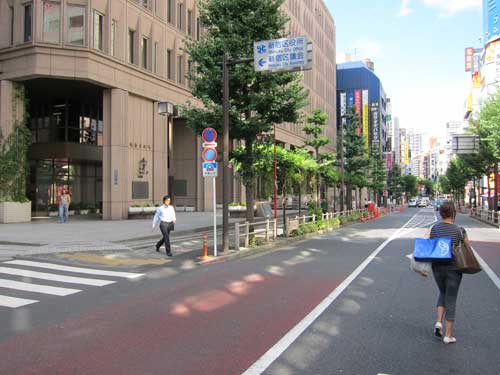
中野駅までの静かな路地は、歩きやすいです。
The house with the orange vine, aka forest house, is where I think Totoro is hanging out with tanuki. This quiet alley rarely has cars, and it makes for a calm walk to the station.

花がいっぱい咲いている蔓植物が路地の前の窓にちょっとしたプライバシーを提供しています。濃い青色の陶器タイルもきれいですね。
I love how this easy to grow vine sends its growth down. The owner has trained it over the street-side window so that it provides additional privacy. There’s also two types of bamboo shades, and three spider plants. I also like how the blue ceramic tile adds a decorative element to what is a very functional architecture typical of post-war Japan.
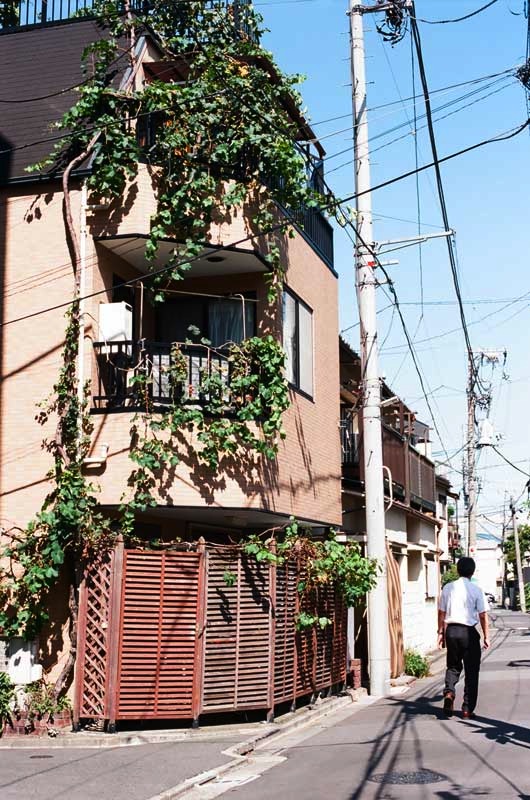
I wonder if this grape vine is as old as the house. It appears to be growing out of the tiniest opening between the house and the street.
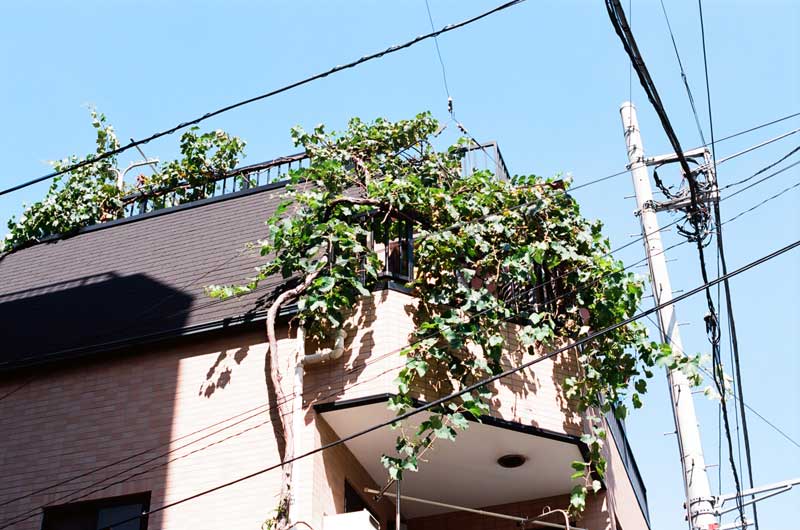

経堂駅から農大に行く途中で、面白い庭がある家をいつも観察します。去年は色々なアサガオが育っていました。今は、背の高いフウセンカズラがたくさんの緑とオレンジ色の実を見せてくれています。私たちのベランダにもこの夏のつる草があります。
On the long walk from Kyodo station to Nodai (Tokyo University of Agriculture), there’s a house and large garden where the residents are always gardening. This year they created a huge, two meter high trellis of fusenkazura (フウセンカズラ). The name is literally balloon kudzu, and despite looking delicate, it’s very hardy. The vine produces lots of white flowers, followed by a multitude of green balls that then turn orange. This year, I’m growing two specimens on our balcony.

この花が咲いているつる植物は繊細に見えます。友達のイアンとゆきとパットの台所の窓から。
I like this delicate, flowering vine growing outside the kitchen window at my friends Ian, Yuki, and Pat’s house.
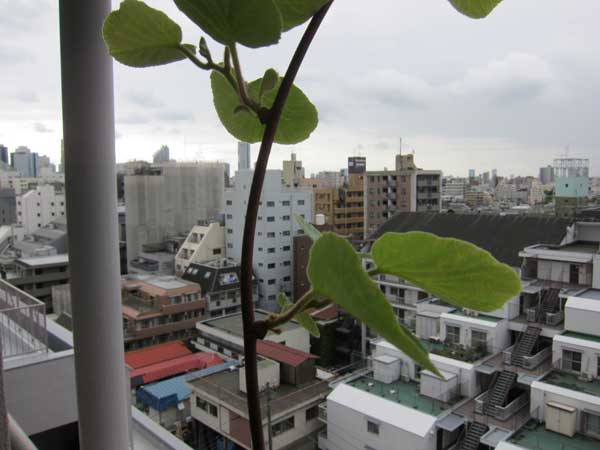
キウイの葉はきれいな形です。春に、若葉がとても新鮮に見えます。キウイのフルーツのように、男性と女性の木がいるでしょうか。うちのベランダには一つだけしかないですが、たぶんどこか隣に違う性のキウイがあればいいです。
I love the shape of this kiwi vine’s leaves. They look so fresh and new. I am not sure if you need a male and female kiwi to produce fruit. I hope one of our neighbors has the right sexed kiwi to activate ours!

スナックエンドウは東京のベランダに育ちやすいです。つるは上に育つので、小さいスペースでも大丈夫ですね。冬に植えて、今食べられます。
I am surprised more people aren’t growing snap peas on Tokyo balconies. Because they’re climbers, they take up very little room. I planted them in winter, and now they are ready to eat!


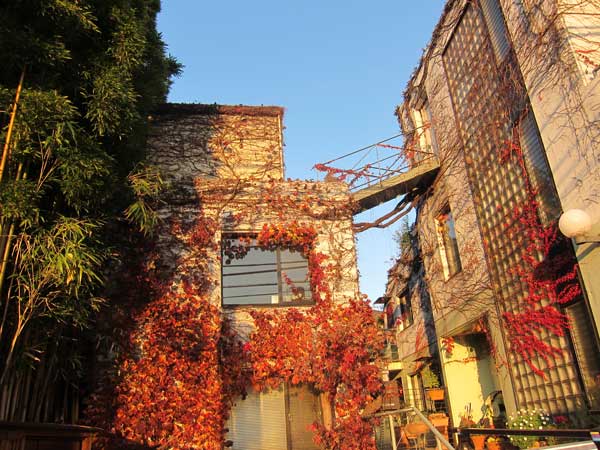
This Harajuku residential buidling is bordered by tall bamboo and covered in a thick vine. I posted a photo of this building last summer shaded in dense green foliage. Now it’s turned red in early winter, and the contrast is very pleasing.

A huge advantage of our small apartment is that both the kitchen and the living face the balcony garden. I love how this ficus vine has crossed the line between outdoor and domestic space.
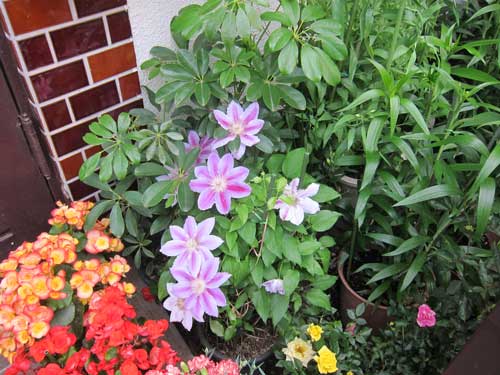
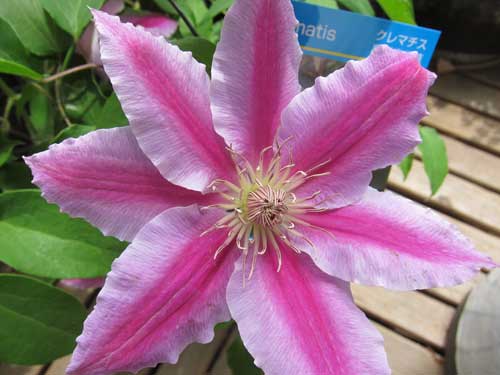

ベランダのジャスミンが咲き始めている。ちょっと早いかな?
Our balcony jasmine just started blooming this weekend. It’s early, isn’t it? The balcony is already filling up with this sweet scent.
This potted jasmine is growing behind the washing machine and up onto the net that will again support our summer green curtain. It hardly went dormant in the winter.
I planted this jasmine last year in a fairly small pot. While I thought it might bloom last year, it never did. It can be hard to know how long to wait when a plant doesn’t grow well at first, especially if you have a limited space like an apartment balcony. This time, I am glad I was patient.

屋上と壁の庭はきれいなんです。
Recently, Mukunoki Ayumi gave me a tour of Kuboco, the construction and roof garden company where she works in Shitamachi. She graduated from Nodai, where I am a research fellow. The meeting took place thanks to Edgy Japan‘s Yanigasawa Hiroki. I immediately recognized the building when I spotted the incredible wisteria that is trellised across one building and climbs to the top of the adjoining 8 story building, where it provides rooftop shade on a trellis structure. Mukunoki-san told me that the vine is just eight years old and very vigorous!
Kuboco designs roof gardens and vertical gardens for commercial and retail buildings as well as residences. Since they are a construction company, they are able to combine garden design and maintenance with structural engineering, water-proofing, and retrofitting trellises for vines and vertical gardens onto older buildings.
Mukunoki-san reports seeing a shift from roof lawns to vegetables in Tokyo. She attributes this to customers wanting less maintenance and greater value from their outdoor spaces. Kabuco has roof gardens on both of its buildings, one a more social space and the other full of experiments with soil depth and new vegetables. Kuboco is very hands-on in providing advice about how to build roof gardens and what to grow. Mukunoki-san explained that last summer she grew tumeric because one of her clients wanted to grow it. On my visit, I saw blueberries, carrots, onions, parsley and other food on their demonstration gardens, and admired how they are testing out what can grow in 5, 10, 20, and 25 cm deep soil boxes. And for a while Kuboco’s roof garden provides fresh vegetables to a local onigiri restaurant.
She also introduced me to the Japanese term for “local food”: 地産地消 (chisanchishou, locally produced and locally consumed, with the first and third kanji being the word soil).


The 8 year old wisteria looks like it’s been on this building for much longer. It blooms best when trained horizontally.

I would love to try blueberries, too. It would be so satisfying to eat fresh blueberries, rather than the supermarket ones that have travelled from as far as Chile.


Across from the 246 elevated freeway in Meguro I saw this simple green wall make of ficus vine. It only extends one story high, but it provides a nice experience for pedestrians on the sidewalk. Along with the typical ginko street tree and azalea bushes between the sidewalk and road, the wall uses minimal space to provide a green corridor. Apart from occasional trimming, I imagine it’s very low cost and low maintenance.


This is the second okra plant I have spotted along the small street leading from my apartment to the JR station. I was impressed with how beautiful its flower is. In the background is a climbing bitter melon vine, and a dog house. The “yard” is paved, so all the plants are in pots.

A friend told me to check out this green “bus stop” between Kabukicho and Hanazono Shrine. This incredible vine providing shade for the sidewalk is no longer a bus stop, but is in front of Shinjuku’s ward office. As I’ve written before, the wards seem to be leading Tokyo Metropolitan Government and the national government in creating innovative green spaces on their properties.

What’s great about this sidewalk awning is that it requires minimal space and maintenance, yet impacts thousands of people coming to the ward office, or just passing by on this busy street. Two very kind city workers involved with green space took time out to talk with me about the sidewalk, facade, and roof greening.
The sidewalk awning is a combination of two hardy vines: nozenzakura (ノウゼンカズラ in Japanese or Campsis grandiflora in Latin) with orange flowers, which I have seen in my neighborhood blooming all summer.

The other vine is akebi (アケビ, also called Akebia in English), which flowers and fruits. Wikipedia says that it is frequently mentioned in Japanese literature and evokes images of pastoral landscapes; it’s also considered an invasive in New Zealand and parts of the United States. Here in the heart of Shinjuku, it’s a very attractive shade plant with the added bonus of having distinct seasons.

It was nice to see that parts of the facade have vertical plantings, although a simple full facade retrofit would modernize and make more attractive the 1960s building.

The city workers also showed off the roof garden, which has different areas including edibles, herbs, and water plants. It was sad that most of the usage seems to be a place for smokers to congregate. I wonder how they can make the space more attractive for non-smoking workers and neighbors.
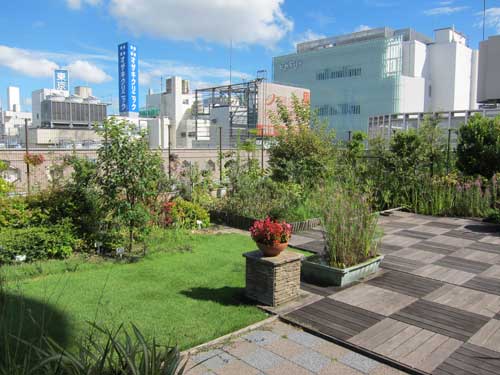

It would be cool to see a complete redesign of the entire usable surface of the ward office to eliminate the dead space. Too much of the facade is monotonous concrete with minimal pattern, and too much of the plaza in front and along the side is hard surfaces. A redesign could capture the imagination of residents, retailers, and office owners.

